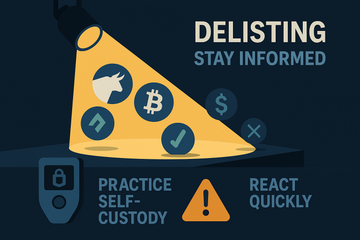Let’s face it: The markets, whether crypto or stocks, are a lot like a bustling talent show. Assets perform for their place in the spotlight, hoping to wow investors, stay relevant, and—maybe—go big. But what happens when they don’t make the cut? Cue the term “delisting.” If you’ve caught that word swirling around financial or crypto circles, you’re not alone. The thing is, delisting isn’t just industry jargon. It can have real effects, sometimes catching folks off guard. Curious how? Let’s break it all down—just like we might hash out the fate of a band that vanished from the charts overnight.
What Exactly Is Delisting?
Delisting is pretty much what it sounds like: an asset—maybe a stock, maybe a digital token—gets booted off its exchange. No more public trading on those familiar platforms. Think of it like being removed from the shelves at your local shop; ordinary folks can’t pick it up as easily anymore. (See Cobrief: Delisting Overview.)
This can play out on the New York Stock Exchange, Nasdaq, or even on big crypto exchanges like Binance or Coinbase. Sometimes the company asks for it—a voluntary exit, hoping to save on paperwork and reporting headaches. Other times, it’s more like getting kicked out for breaking the rules. Maybe the asset’s price drops too low, or the company drops the ball on filings. Either way, the asset ends up ‘going dark’ to some extent, losing its easy-access status.
Why Do Assets Get Delisted?
Now, you might wonder, “Why would anyone want that?” Well, voluntary delisting happens more than you’d expect. Some companies are tired of the stiff rules, snooping eyes, and high costs of public life. They cash out their public shares and go private. That’s not always bad news, but it can make things awkward for folks holding those shares—liquidity dries up, and prices can bounce around wildly.
But the story isn’t always intentional. Often, it’s involuntary: numbers just don’t add up, and rules get broken. Nasdaq, for example, has a minimum price rule. If a stock can’t keep its head above a dollar for a while, it’s at risk. The exchange might file official paperwork (Form 25 with the SEC, for the curious) and make it final after a set period (NYSE: Delistings).
Caught Off-Guard: The Effects of Delisting
Let’s not sugarcoat it—a sudden delisting can blindside investors. Suddenly, your easy trade buttons are gone. The asset might still exist, but now you’re stuck looking for sketchy over-the-counter (OTC) venues or obscure crypto swaps to trade your holdings. The crowd thins out, too. Market makers scramble, prices turn volatile, and selling at ‘fair value’ becomes even trickier. It’s like trying to sell concert tickets for a band that’s just broken up; only a few diehards are left looking to buy.
But there’s another wrinkle: Companies sometimes delist, thinking they’ll dodge regulatory watchdogs—but if they don’t deregister with the SEC, they’re still on the hook for some reporting requirements, especially if they have more than 300 shareholders (Skadden: Going Dark).
Crypto’s Twist: Token Delisting and User Anxiety
Who hasn’t heard of a token suddenly disappearing from Binance or Coinbase? In crypto, delisting can whip up confusion—a digital asset might get pulled for legal reasons, security concerns, or just because the project went quiet. The panic isn’t just about trading; sometimes wallets and swaps stop supporting the asset, trapping unsuspecting users.
There’s also a rush to withdraw tokens before the exchange shutters the withdrawal window. Miss the deadline, and your coins can be frozen, stuck in limbo. Sound stressful? That’s because it is—sometimes, it feels like musical chairs with everyone scrambling for a seat as the music winds down.
Protecting Yourself: Don’t Rely Just on Exchanges
So, what’s a prudent investor or crypto enthusiast to do? For stocks, keeping an eye on news and compliance bulletins helps. If you spot persistent rule violations or rumors of poor performance, it doesn’t hurt to dig deeper. But if you’re into crypto—here’s where things get interesting.
Crypto’s magic trick is self-custody. Ever heard of hardware wallets like Trezor or Ledger? These gadgets are the Swiss vaults of the crypto world. Instead of parking your coins on an exchange (where shutdowns or delistings can sweep your assets off the board), you hold them yourself. Sure, there’s a bit of a learning curve, and you could misplace your password (don’t laugh, it happens!), but you’re not at the mercy of distant exchanges.
- Stay Informed: News travels fast. So does misinformation. Official channels and community forums are your “eyes and ears.”
- Practice Self-Custody: With hardware wallets, you hold the keys—literally. Accounts on Trezor or Ledger can be your buffer against sudden withdrawal suspensions.
- React Quickly: If you hear of a potential delisting, act sooner rather than later. Withdraw, swap, or sell before windows close.
Digression: Not Every Delisting Is a Disaster
It’s easy to feel anxious, seeing headlines about delisting. But honestly, not all delistings spell doom. Sometimes, companies regroup after taking their stock off the exchange, and eventually make a comeback. Other times, the crypto project quietly sunsets with little fuss. The problem is, without transparency, users are left in the dark. Remember RadioShack or Kodak? Sometimes, what’s old becomes new again—just in unexpected ways.
Wrapping It Up—But Not Sweeping It Under the Rug
If you take just one idea from this, let it be this: Delisting isn’t some arcane sentence reserved for failing companies or scammy crypto coins. It’s part of the market’s rhythm—sometimes bumpy, sometimes necessary, sometimes a fresh start in disguise. It can feel personal when it happens to your favorite asset, but with the right tools (hello, Trezor and Ledger!), information, and a dose of caution, you’ll have the upper hand.
And the next time you spot “delisted” beside an asset’s name, you’ll know it’s not the end of the story. It’s just another plot twist—and savvy investors know how to handle a good twist.











